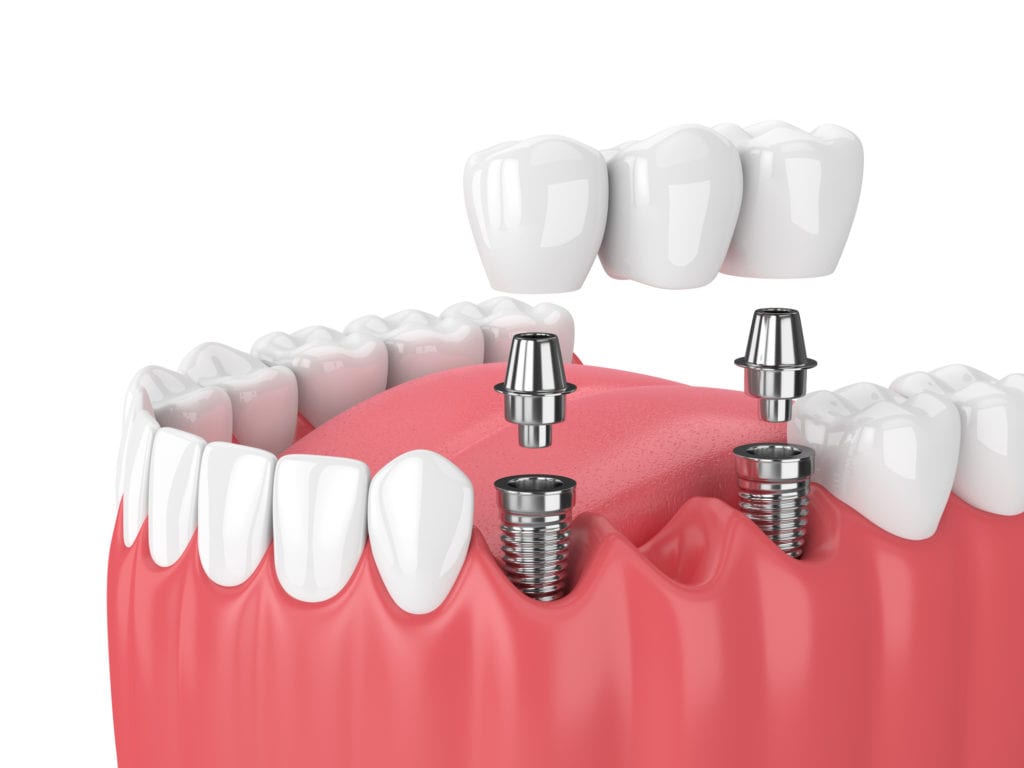Are you missing multiple teeth in a row? Do you want a full, balanced bite?
A dental bridge can restore multiple lost teeth for a natural-looking, functional smile. Dental bridges typically attach prosthetic teeth to adjacent natural teeth or abutment teeth. They are permanently fixed or removable. Dr. Josh Heinsheimer and his team provide dental bridges to replace lost or missing teeth in Leland, NC.


Traditional Vs. Implant-Supported Dental Bridges
Traditional dental bridges are usually removable and use your natural teeth as anchor teeth. They’re especially good for short-term solutions. Traditional bridges don’t give you back full bite function and usually need to replace once or multiple times.
Using natural teeth as anchors can cause problems, too. Anchor teeth are more likely to suffer from tooth decay and other problems because of stress. Dental crowns are used to strengthen the anchor teeth, but crowns still require the removal of tooth structure.
Implant-supported dental bridges are a more permanent solution. Instead of using natural teeth as the anchor, two dental implants are used. Because of the stability of the implants, you’re able to get the full bite function back for these teeth.
Implants also help to eliminate some of the problems that are common with missing teeth. They reverse the impacts of bone degeneration so you don’t have to worry about the look of a sagging face that comes with losing teeth.
The best part about traditional bridges is that they can be done quickly. You’re able to get your teeth replaced fast and get back to daily life. However, your jawbone will continue to deteriorate and you’ll have to get your bridge readjusted or replaced to make sure that it still works as your jawbone changes.
While implant-supported bridges last longer, they also take longer to get. The implants have to be surgically placed and they have to heal and fuse with the jawbone for 3-6 months before things can continue. Not everyone is eligible to get dental implants, either.
We’ll have to do a full exam and make sure that you have enough healthy bone structure to support implants properly. A consultation is always done to make sure we get the right bridge choice for your unique case.
Dental Bridge Treatment
To begin traditional fixed dental bridge treatment, our dentists prepare the teeth on either side of the missing tooth gap for the dental crowns. Once the dental crowns for these teeth are complete and attached to the teeth, we will provide you with a temporary dental bridge.
Meanwhile, the permanent bridge will be fabricated in a dental laboratory. We will ensure that the bridge fits comfortably in our office when it is completed.
If you’re getting an implant-supported bridge, the implant surgery will have to go first. The implants will be placed in the jawbone and you’ll be fitted with a temporary restoration while they heal.
A custom restoration will be made for you and will be attached when the healing process is complete. Usually, these bridges are a lifetime restoration. Because the implants are stable and the bone deterioration shouldn’t continue, they can last much longer.
Dental Bridge FAQs
How long will it take for me to get used to a dental bridge?
Give it about two weeks to become fully adjusted to your new dental bridge. It takes some time to feel natural in your mouth. Eating and speaking will become easier with time. If you’re using natural teeth as anchors for your bridge, you’ll also notice some sensitivity to hot and cold foods and beverages in these early days as well.
How long do dental bridges last?
If your dental bridge is supported by implants, it’s considered a lifetime restoration. You should be comfortable with it for years to come. Using your natural teeth, the bridge won’t last as long. However, most can last about ten years or more. They last longer the better you take care of them.
How do I clean under my dental bridge?
With a removable bridge, you take it out and clean it separately from your teeth. There are various tools that can help you clean underneath a permanent bridge. Special floss tools and brushes are designed for cleaning underneath appliances and restorations. Your dentist can help recommend a good one for your specific case and teach you how it’s used.
Can I chew gum with a dental bridge?
We recommend you avoid gum if you have a dental bridge. If your bridge is removable, gum can be sticky and hard to get out. It’s best that chewing gum is avoided completely.
What can’t I do after getting a dental bridge?
For the first week or two, avoid crunchy or hard foods. Things like this can dislodge the bridge or cause discomfort. Use discretion as you slowly work in harder and harder foods after a soft diet.
Is a dental bridge the best choice for me?
We take into consideration many things when we’re replacing missing teeth. We’ll go over your budget, oral health, and do a full oral exam. With all of these data points, we help you determine what solution is best for your smile!
How many teeth can you have on a bridge?
>There are a number of factors that can affect the number of missing teeth that can a bridge can connect between two abutments, but in general, the maximum number is four. In addition to bridging the gap between two teeth or implants, a bridge can span wide gaps between multiple teeth.
Can my bridge be re-cemented?
In many cases, dentists can simply re-cement a bridge that has become loose back into place. The cement used to bond a bridge in place is long-lasting and is permanent. Although it can be difficult to remove a bridge, re-cementing one is an easy process.
Getting A Dental Bridge In Leland, NC
Do you think a dental bridge is the solution to replace your missing teeth? Call us or schedule an appointment online.
